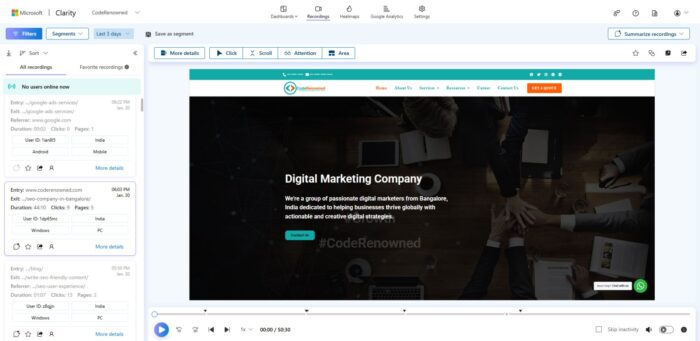Table of Contents
Search Engine Optimization (SEO) has been a crucial element in digital marketing strategies. SEO traditionally focused on keyword optimization, backlink generation, site structure, and load speed. User experience (UX) has emerged as an essential ranking factor reflecting a broader understanding that search engines aim to deliver high-quality, engaging content that meets user needs and expectations. The below article explores why UX has become a vital component of SEO and how businesses can use it to enhance their online presence and performance.
What is User Experience (UX)?
Ever landed on a website that took forever to load, had annoying pop-ups, or was just plain hard to navigate? Frustrating, right? That’s bad UX (User Experience).
UX is all about how people feel when they interact with your website. A good UX ensures visitors can easily find what they need, stay engaged, and enjoy the experience. It includes factors like:
- Navigation – Can users find what they’re looking for quickly?
- Page Speed – Does your site load fast, or does it make visitors wait?
- Mobile-Friendliness – Is your site optimized for mobile users?
- Content Readability – Is your content clear and engaging?
- Overall Design – Does your website look clean, modern, and professional?
Now, let’s see how SEO (Search Engine Optimization) has evolved to prioritize UX.
The Evolution of SEO: From Keywords to Experience
Traditionally, SEO only focused on technical components and keywords, and search engines relied on keyword density and meta tags to rank pages, leading to keyword stuffing and low-quality content designed to manipulate rankings. Over time, search engines like Google have become more refined by including factors to evaluate website quality and relevance.
- Old SEO (Pre-2015) – Focused on keyword stuffing, meta tags, and backlinks.
- Modern SEO (Now) – Prioritizes user intent, site performance, and overall experience.
Google’s major algorithm updates have forced websites to focus on quality and user engagement rather than just technical tricks:
- Panda Update (2011) – Penalized low-quality content.
- Penguin Update (2012) – Targeted spammy backlinks.
- Hummingbird Update (2013) – Focused on understanding search intent.
- RankBrain (2015) – Introduced AI to evaluate user behavior.
- Core Web Vitals (2021) – Made UX a direct ranking factor.
So, if you’re still thinking SEO is just about keywords, you’re missing the bigger opportunity. Google now ranks sites based on how well they serve users, not just how well they’re optimized for search bots.
Why UX is Now a Critical Ranking Factor?
Google Core Web Vitals: UX Metrics That Matter

Google has officially made Core Web Vitals (CWV) a ranking factor, measuring three key UX signals:
- Largest Contentful Paint (LCP): Measures page load speed. 💡Aim for under 2.5 seconds.
- First Input Delay (FID): Measures responsiveness. 💡 Aim for under 100 milliseconds.
- Cumulative Layout Shift (CLS): Measures visual stability.💡Keep it below 0.1.
Why it Matters:
If your website loads slowly, is unresponsive, or jumps around while loading, users will leave instantly, leading to lower engagement and rankings.
Actionable Tip: Use Google PageSpeed Insights and Web.dev to check your Core Web Vitals and improve them.
Mobile-First Indexing: Your Mobile Site is Your Real Site
More than 60% of all web traffic comes from mobile devices, and Google now ranks your site based on its mobile version first (Mobile-First Indexing). If your site isn’t mobile-friendly, your website will struggle to rank top for competitive keywords.

What Google Looks for in a Mobile-Friendly Website?
- Responsive design (fits all screen sizes)
- Fast loading speed (especially on 4G/5G networks)
- No intrusive pop-ups ( Create bad user experience & Google penalizes them)
- Easy navigation with large buttons
Mobile usability is crucial for UX, enclosing responsive design, fast loading times, and easy navigation on smaller screens. Websites that fail to deliver a great mobile experience are likely to see their rankings suffer.
Behavioral Metrics: Google Watches How Users Interact With Your Site
Google tracks how users engage with your website and uses this data to determine rankings. The better the user engagement, the higher your chances of ranking well.

Key UX Signals Google Monitors:
- Bounce Rate: If users leave quickly, Google assumes your site isn’t useful and drops your ranking.
- Dwell Time: The longer visitors stay, the more valuable Google sees your content.
- Click-Through Rate (CTR): Higher CTR = More relevant and engaging content.
Actionable Tip: Use Google Analytics & Microsoft Clarity to track user behavior patterns and identify areas where users drop off. Ensure your content is engaging, scannable, and easy to navigate to keep visitors on your site longer.
Content Quality and Engagement: Is Your Content Actually Helpful?
Google doesn’t just rank content—it ranks how useful and readable your content is.

What makes content UX-friendly for SEO?
- Clear structure (short paragraphs, bullet points, headings)
- Scannable format (bold key points, use visuals)
- Answers user intent quickly (no fluff, just value)
- Multimedia elements (images, videos, charts)
How to Blend UX into SEO Strategies?
Improve Page Load Speed
- Fast-loading pages are crucial for user satisfaction and SEO, as slow pages can frustrate users and lead to higher bounce rates.
- Google Page Speed Insights can identify areas for improvement by optimizing images, leveraging browser caching, and minimizing JavaScript to enhance load times.
Enhance Mobile Experience
- A seamless mobile experience to adopt a responsive design approach that adjusts to different screen sizes, optimizing images and content for mobile devices.
- Ensure navigation is intuitive and accessible.
- Regularly testing the site on various mobile devices helps to identify and fix usability issues.
Create High-Quality Content
- Content should be informative, engaging, and tailored to users’ needs.
- Conduct keyword research to understand what the audience is searching for and create content that addresses those queries.
- Include multimedia elements like images, videos, and infographics to enhance engagement and provide a richer experience.
Improve Navigation and Site Structure
- A well-organized site structure enhances usability and helps search engines crawl and index the site more effectively.
- Use clear, descriptive headings and subheadings, and ensure the navigation menus are logical and easy to use.
- Implement breadcrumb navigation to help users understand their location and way back to previous pages.
Focus on Accessibility
- Websites should be usable by people with disabilities, include text alternatives for images, ensure functionalities are accessible via keyboard, and use a logical tab order.
- Tools like WAVE and Google Lighthouse can identify accessibility issues.
Monitor and Analyze User Behavior
- Monitoring with user behavior tools like Google Analytics can provide insights into interactions with the site.
- Analyzing metrics like bounce rate, average session duration, and pages per session identifies areas of the user experience lack.
- Implementing A/B testing can determine changes leading to better user engagement and satisfaction.
Case Studies: Successful Integration of UX and SEO
Amazon
- The success of Amazon can be its relentless focus on user experience.
- The site is user-friendly, with intuitive navigation, personalized recommendations, and fast loading times.
- The efficient site structure and high-quality content make it easy to find and purchase products quickly, which helps it achieve and maintain high search rankings.
Airbnb
- Its website and app are the best examples of seamless UX integration, as it offers an intuitive search function, clear and detailed listings, and a smooth booking process.
- The commitment to high-quality visuals and comprehensive information makes informed decisions, leading to high user satisfaction and strong SEO performance.
Moz
- Moz, a leading SEO software company, provides valuable content, blog posts, guides, and tools.
- Their site makes content easily accessible, with detailed navigation and an intuitive layout.
- Its focus on providing in-depth, high-quality information has helped to build the best online presence and rank highly in search results.
- Amazon – Fast, easy checkout = high conversion & retention.
- Airbnb – Clean design + intuitive search = seamless UX.
- Moz – High-quality content + smooth navigation = industry authority.
Lesson? Better UX = Higher rankings + More conversions.
What is the Future of UX and SEO?
As technology evolves, the integration of UX and SEO will become even more essential. Emerging technologies like artificial intelligence (AI) and machine learning are more refined analyses of user behavior and preferences for more personalized and engaging experiences, which search engines reward.
Voice search is another trend that can impact UX and SEO. With the rise of smart speakers and virtual assistants, optimizing for voice search will require natural language processing and conversational queries. Ensuring that content is easily accessible and answers users’ questions directly will succeed in this new era.
Conclusion:
The confluence of UX and SEO reflects a broader trend by prioritizing user satisfaction in marketing. By creating high-quality, engaging experiences, businesses can improve search rankings and build stronger connections with their audience. The future of SEO lies in understanding and meeting user needs, making UX an essential component of any effective SEO strategy.
By integrating UX principles into SEO strategies, businesses can create a more engaging, user-friendly web presence that drives traffic, conversions, and long-term growth.
Written By

Shiny Suresh
Shiny S is a strategic marketing mind with a sharp focus on driving growth through content, SEO, and brand storytelling. Currently serving as a Marketing Strategist at CodeRenowned, she helps businesses scale with revenue-driven strategies that align marketing execution with business outcome… Know more






